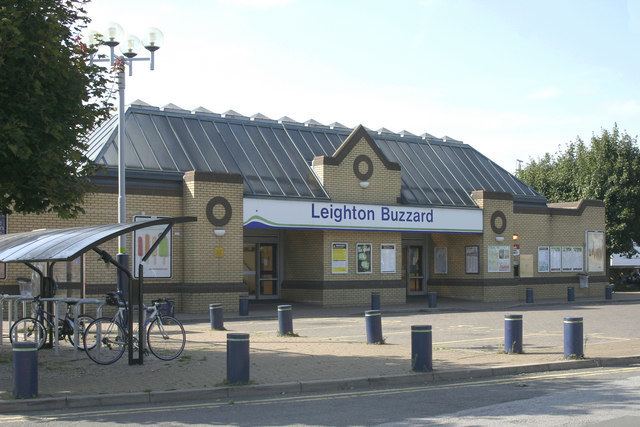Station code LBZ DfT category C2 Number of platforms 4 | Grid reference SP910250 Managed by London Midland 2011/12 1.589 million | |
 | ||
Similar Bletchley railway station, Berkhamsted railway station, Hemel Hempstead railway st, Milton Keynes Central ra, Tring railway station | ||
Leighton buzzard railway station 23 5 2016
Leighton Buzzard railway station serves the Leighton Buzzard and Linslade area of Bedfordshire and nearby parts of Buckinghamshire. Actually situated in Linslade, the station is 40 miles (64 km) north west of London Euston and is served by London Midland services on the West Coast Main Line. Until the 1960s the station was the start of a branch to Dunstable and Luton, with a junction just north of the present station. There have been past proposals about reopening this route, as little of it has been lost to new construction, either for rail or as a guided busway. There is now a guided busway from Dunstable to Luton, but much of the Leighton Buzzard to Dunstable section was lost to the town's southern Bypass. The station has four platforms. Platforms 1 & 2 serve the fast lines and are used by Virgin Trains services running non-stop to/from London Euston. Platforms 3 & 4 are served by slower London Midland services to/from London Euston and by Southern services between East Croydon and Milton Keynes Central.
Contents
- Leighton buzzard railway station 23 5 2016
- History
- Motive Power Depot
- Accidents and incidents
- Services
- Other information
- References
Page's Park railway station, terminus for the Leighton Buzzard Light Railway (a narrow gauge heritage railway), is on the opposite side of the town.
History
The first station simply known as Leighton was opened by the London and Birmingham Railway on 9 April 1838 as part of the first section of its line from London Euston to Denbigh Hall. The line had originally been planned to pass through Buckingham but opposition from the Duke of Buckingham ensured that it forced east through Linslade. A station with two-facing platforms was opened a ¼-mile south of the Linslade tunnels. These are arranged unusually for a four track main line: the southbound slow line has a tunnel to itself as does the northbound fast line, however the northbound slow and southbound fast lines share a tunnel. This stems from the fact that the line was built as double-track and when quadrupled, the two extra lines could only be placed along both sides, as single-track tunnels.
In May 1848, the station became a junction when a branch line to Dunstable was opened. The London and North Western Railway replaced the first station in February 1859 by another more permanent structure located 8 chains (160 m) to the south. The new building had an imposing frontage featuring arched windows. Access to the Dunstable branch was controlled by Leighton No. 2 signal box situated to the north of the station, while the actual branch signals were controlled by the main line box to the south. In 1874, land was purchased to the south of the station alongside the Dunstable branch for the construction of goods sidings, which eventually became known as Wing Yard.
The LNWR was absorbed by the London, Midland and Scottish Railway in the 1923 railway grouping and, in 1927, it added a crossover between the fast and slow lines. This was to play a significant role in the derailment of Royal Scot No. 6114 "Coldstream Guardsman" at Linslade on 22 March 1931 when the driver took the crossover at 50-60 mph instead of the regulation 15 mph. There had been a diversion in place on the fast lines and the driver had missed the warning signals. The engine overturned and six people were killed including the driver and fireman.
In 1957-8 the platform buildings were rebuilt and a concrete awning placed over the platform. At the entrance a larger booking / waiting hall, central heating, electric lighting and the cycle storage, parcels and loading bay were improved.
The Great Train Robbery of 1963 occurred just south of this station, at Bridego Bridge near Ledburn, at a bridge on the southbound stretch towards Cheddington. Wing Yard was closed in February 1967 and it is now used as a car park, while the branch to Dunstable was closed from June. In 1989, the platforms were lengthened to accommodate 12-coach trains and a £1.8m project to rebuild the station was started.
Motive Power Depot
The London and North Western Railway opened a small motive power depot at the south end of the station in 1859. This was reroofed in 1957 but closed 5 November 1962 and was demolished.
Accidents and incidents
Services
The station is served by London Midland and Southern, and is managed by London Midland. Southbound, three London Midland trains depart per hour on weekdays, one of which runs non-stop to London. Additionally, one Southern train per hour runs to South Croydon. Northbound, two trains an hour run to Milton Keynes Central, one from London Midland and the other from Southern, one train per hour to Northampton and two trains an hour to Birmingham New Street. There is also one train on weekdays to and from Crewe and some services to/from Crewe on Sundays.
Other information
The station played host to a tragic event on 11 April 2011 when a 43-year-old woman named Sarah James, from Uxbridge, Middlesex, kissed an elderly passenger aboard the 16.25 Northampton to London Euston service which was approaching the station from the north, and set fire to herself within the confines of a train toilet with a can of explosive gas. The train immediately stopped at the station and the passengers were evacuated. The unusual suicide method caused great distress to the passengers and closed the West Coast Main Line for several hours whilst emergency services attended to the fire.
